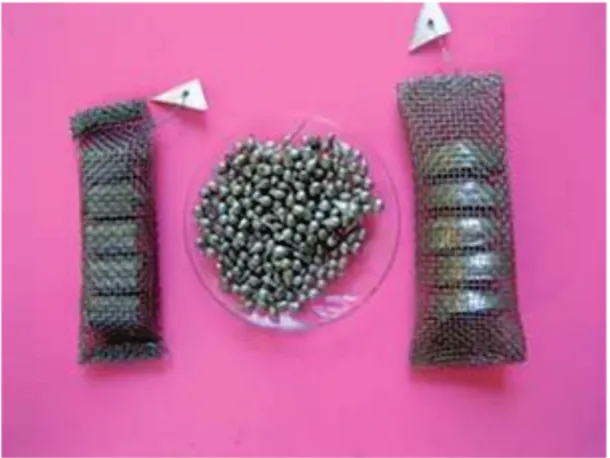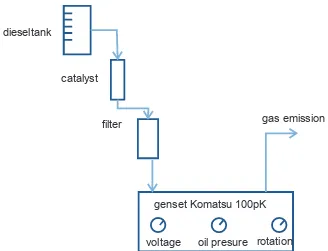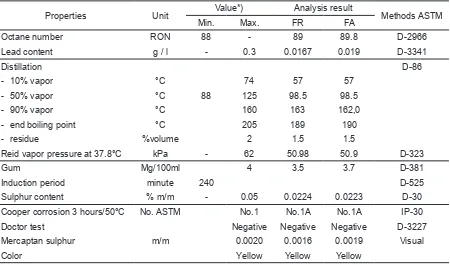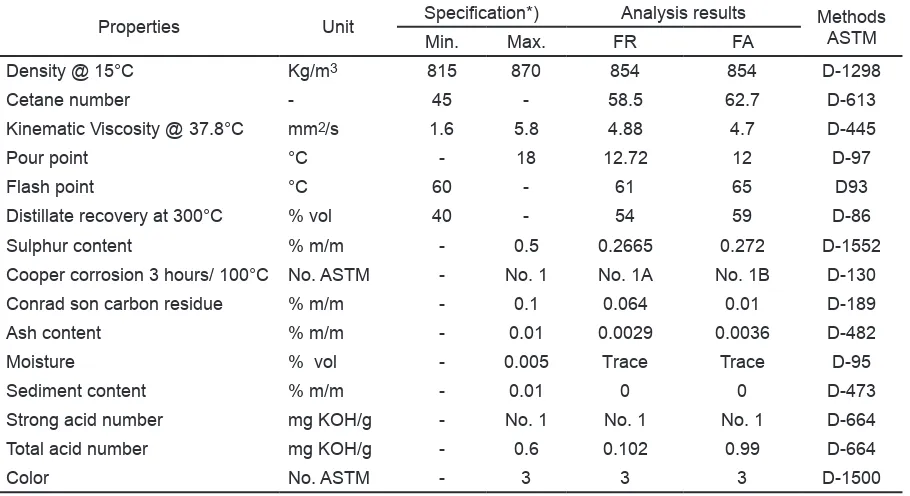tin-based alloy for fuel catalyst
logam paduan berbasis timah sebagai katalis
bahan bakar
1siti rocHani, 2PraMusanto and 1retno daMayanti
1 Research and Development for Mineral Coal Technology Jalan Jenderal Sudirman no 623 Bandung 40211, Indonesia
Ph. 022 6030483, Fax. 022 6003373 e-mail: [email protected]
2 Universitas Islam Bandung Jalan Taman Sari No. 1 Bandung Ph. 022 4205546, Fax. 022 4263895
ABSTRACT
Tin-based fuel catalyst, if dipped into a gasoline-containing tank will increase fuel efficiency. The catalyst has been used since 60 years ago. Its usage will save the fuel and increase the use of tin as expected by tin-producers. Though the mechanism of catalytic reaction has not been clearly understood, several research regarding catalyst performance have been conducted. Moreover some companies have already produced such a catalyst. The tin alloy catalyst was made by melting tin and other metals at specific compositions in a burner and casted into dif
-ferent shapes. In term of evaluating the contact between the fuel and the catalyst as well as assessing the alloy catalytic mechanism, the samples were dipped in gasoline and stirred for 3 days. The gasoline with and without catalyst were analyzed using infrared and showed that the spectra appeared at 875, 835, 538, 343 and 229 cm-1 after 3-day dipped. The peaks resulted for catalytic interaction between Sn and gasoline. Fuel efficiency was measured through static and dynamic tests. The former was conducted using a genset and lawn mower by running the diesel-containing engines in empty load condition. The result showed that efficiency of catalyst-containing diesel consumption was still low, ranged between 0.6 - 5%. Other static tests were performed at LEMIGAS using Toyota and Isuzu car engines. Using gasoline and diesel respectively. Effect of catalyst on the car with gasoline improves engine capacity to 8.79%, and increases fuel consumption to 1.03%. The catalyst applied the car with diesel enhances the capacity to 11.38 % and increases fuel consumption to 9.39%. Dynamic tests conducted to motor bikes and cars show the efficiency of fuel consumption around 5-17.5%. It means that tin-alloys based catalyst for efficiency of fuel use is prospective. Such a catalyst is easy to be made and utilized.
Keywords: tin alloy, fuel catalyst, infrared spectra, fuel efficiency
Sari
introduction
The use of tin-based alloy catalysts for fuel effi -ciency started in World War II era. Such a technol -ogy was called Carbon Flo that was introduced into the fuel prior to enter the machine. This catalyst has advantages as shown by research result, conducted by the Environmental Protection Agency (EPA). The researcher placed the catalyst in front of the fuel pipe near the fuel injector or carburetor and was immersed in the fuel tank. Its result showed that the catalyst increased the ef -ficiency and improved the combustion as well as reduced the released pollutants that usually came from incomplete combustion. Catalytic reaction suggests that when the fuel passes through the catalyst, it will change the molecular structure of the fuel. As a result, it produces a better power. It is proved from the laboratory and road tests that the catalyst reduces carbon formation in the engine. The engine performance will improve and reduce the maintenance cost. The improved effi -ciency of fuel was reported between 6.5 – 24% for the road tests but the efficiency for laboratory tests is between 10-22%. In addition, the release of toxic gases also reduced up to 40% and showed a decreasing black smoke (Anonymous, 1993).
Currently, several catalyst products are Broquet, Fuel Catalyst, Fitch, Prozone, Fuelcat, Enviromax, Plus, Vitalize, Firepower, PICC, Euro FuelSaver. (Anonymous, 2012; Pearce, 2013). They are applied in cars, trucks, motorcycles and marine installations. Referring to such potential uses around 10,000 tons of tin might be consumed due to the high tin-contained alloy (Cussack, 2013).
Preparing tin catalyst is simple due to its process just involves melting and casting the material. Moreover, effect of the catalyst is highly benefi -cial to reduce air pollution from the engine. The
catalyst is also proved to make fuel efficient. This leads to the main objective of this study, namely beneficiating local tin utilization. This study is a continuation research on fuel catalyst that is based on tin alloys as already conducted by Rochani in 1998. It focuses on examining the performance of tin based catalyst in improving fuel efficiency. Research was conducted at the Research and Development Centre for Mineral and Coal Technology, Lemigas Laboratory and PT Timah as well.
eXPeriMental MetHod
The study methodology includes a basic research and some applications. A basic research examines molecular structure of the catalyst. The structure is supposed to support the theory of consumption efficiency. The application methods consists of two types tests namely static and dynamic tests. Static test was accomplished using engine such as several vehicles, lawn mowers and gensets. The tests run for several hours using fuel with and without catalyst. Fuel consumption in the testing is recorded. Several motor vehicles are used for dynamic tests. The vehicles completed by fuel with and without catalyst are operated at a certain distance. At the end of the tests, fuel consumption efficiency is calculated.
Preparing tin-metal alloy
Tin-metal alloy is made by melting the tin and other metals at specific compositions. The melted material is then casted into different shapes, i.e., spherical and cylindrical forms using the metal molds. Steel wire baskets, each contained of 5 spherical or cylindrical cast alloys, are prepared for a series of dipping tests (Figure 1).
mesin mobil Toyota dan Isuzu. Hasil uji menunjukkan bahwa efek pada penggunaan total bensin selama uji meningkatkan daya 8,79% dengan penurunan konsumsi bahan bakar spesifik sebesar 1,03%, untuk diesel, efek penggunaan katalis dapat meningkatkan daya 11,38% dan pengurangan konsumsi bahan bakar spesifik sampai dengan 9,39%. Uji jalanan dilakukan pada beberapa kendaraan bermotor, baik sepeda motor maupun mobil berbahan bakar bensin dan solar. Hasil percobaan menunjukkan bahwa efisiensi yang dapat dicapai sekitar 5-17,5%. Hasil ini memperlihatkan bahwa penggunaan katalis bahan bakar berbasis timah mempunyai prospek tinggi karena mampu menghemat bahan bakar, mudah dibuat dan digunakan.
Molecular structure tests
In order to examine the contact between gaso -line and catalyst and the mechanism of catalytic process, the samples are dipped into gasoline and stirred using a magnetic stirrer for 3 days. Gasoline with and without catalyst contact are analyzed by infrared.
static tests
The catalyst can be used in two systems, namely dipping it into the gasoline or diesel in a fuel tank, and storing it in a series of separate filter fuel containers that is connected to the fuel pipe prior to pouring the fuel into a carburetor. The test using home genset and lawn mower as auxiliary instrument relates to a dipping system. The ef -ficiency tests of such instruments are conducted by running them without loading condition in a closed room. A trial run is performed to ensure all engines running well, especially for the lawn mower, by removing the cutter blade to prevent unnecessary weight. Both instruments use a diesel as fuel. The experiment conducted at PT Timah uses a genset. The catalyst is kept in a separated container with the fuel tank. Figure 2 shows the experimental design.
Static tests performed at LEMIGAS include per
-on the Bench Multicylinder machines (Figure 3). The employed machines are as follows:
- Machine-18R Toyota which uses premium gasoline (with and without catalyst);
- Engine Isuzu C-223 loaded with diesel (with and without catalyst).
Both diesel and gasoline with and without catalyst are analyzed. For implementation of the perfor -mance test, there are 3 types of tests :
running in; Prior to 50-hour endurance test, a
running test is performed for 3.5 hours, starting from idle, low, medium load to reach 50% condi -tion;
Power test; Power test is accomplished before
and after the endurance test to evaluate the dif -ference of engine performance at different fuel consumption;
50-hour endurance test; The test is carried out
according to the defined test cycles with various speed and loading variations which represents vehicles condition on the road to reach 50-hour run.
Fuel efficiency is calculated by recording the use of fuel with and without catalysts. The percentage of fuel efficiency is calculated by subtracting fuel usage with and without catalysts and divided into the amount of fuel with catalyst, then multiplied
dynamic tests
Dynamic tests are accomplished using two motor -cycles, namely Pro GL 1992 and Honda Legend 2002 and four cars, i.e., Honda 1991, Mazda 1985, Daihatsu Rocky 1990 and Daihatsu Rocky 1992. The dynamic test intends to measure of fuel consumption efficiency and performs on the road by running the vehicles with and without catalyst for several hours. The catalyst used for motorcycles and cars is a dipping system.
results and discussion
Preparing the Metal alloys
Alloy homogeneity is the important thing to get a good catalyst performance. Master alloy was prepared by mixing and melting Banka tin low lead (melting point of 320°C) and antimony (melting point of 630°C) in the burner. The mixing process was accomplished by pouring such materials back and forth for at least ten times. Table 1 shows the fueltank
fuelfilter
catalyst
Toyota machine 18R
carburettor
fueltank
fuelfilter
catalyst
Isuzu machine C-223
fuel pump
Figure 3. A flow diagram illustrated static tests, conducted at Lemigas
dieseltank
catalyst
filter gas emission
genset Komatsu 100pK
voltage oil presure rotation
testing Molecular structure of the alloy
Mechanism of this catalyst system still has not been known; however it is found that a small amount of dissolved metal causes oxidative de- gradation of oil. In this experiment, it is found that the dissolved tin may form organotin compounds to lead a catalytic system working. (Anonymous, 2013a; Anonymous, 2013b). For testing purposes, the catalyst was dipped into gasoline and stirred for 3 days. The changing of molecular structure in the gasoline was checked using the infra red. The results show that the tested gasoline produces some peaks at different spectra. The spectra indicate the presence of catalytic processes on the readability of wave numbers 230 to 875 cm-1. Some spectra appear at different wave numbers as follows 875, 835, 538, 343, and 229 cm-1. The peaks occurred due to the catalytic interaction process between Sn with gasoline. Although these peaks are among the group out plane C - C and there is the area below 400 cm-1 spectra (Silver -stein et al., 1974). The bonds of tin and carbon show the organotin compound had been formed (Rochani, 1998).
testing the catalysts for Genset and lawn Mower.
Result of efficiency test for the entire experi -ment confirms that fuel consumption efficiency in a genset increased to 2.8%. The average soluble catalyst was 6.5 mg. Efficiency in lawn mower increased 5% performing 2.1 mg soluble catalyst. During the experiment, there were some constraints such as generated smoke from the machines.
The observed parameters include oil pressure, voltage and engine rotation. The results showed that the machine was unstable. Therefore, the fuel filter was cleaned and a pressure gauge was installed to measure the fuel pressure entering combustion chamber. After the machine stability was achieved, the measurement of fuel efficiency was conducted during a 3.5 hours period, mea -sured consumption efficiency ranged between 0.6 - 4%.
static tests for Motor Vehicles.
The tests were performed at LEMIGAS. It included fuel analyses, performance test (power and fuel consumption) for 50-hours endurance and flue gas analysis. The employed instruments were Toyota Machine-18R (premium gasoline) and Isuzu engine C-223 (diesel).
Physical and chemical characteristics tests
Premium gasoline
No deviation occurred on the gasoline specified both chemically and physically, when catalyst is passed through the fuel as shows in Table 2. Compared to fuel condition prior to passing it to the catalyst, the octane number and gums increased 0.8 and 0.2 mg/100ml respectively, for the gasoline passed through the catalyst, but the Reid vapor pressure decreased to 0.08 kPa. Re -ferring to the increase of octane number, there is a tendency in increasing the power or the engine. However, the increase of gum leads to addition deposit in the combustion chamber.
Table 1. Composition of master alloy for homogeneity tests
Alloy Sb (%) Sn (%) In ( ppm) Fe (%) Pb (%) No 1. Pellet 1 6.80 90.18 0.007 0.001 2.02 0.003 2. Pellet 2 9.80 85.99 2.02
3. Pellet 3 8.78 88.28 2.02
type of various composition alloys for homogene -ity tests. The best catalyst composition catalyst is 76.46% Sn, 22.03% Sb and 0.006 % Pb.
diesel fuel
Similar to premium gasoline, deviation did not occur to chemical and physical characteristics of the diesel fuel before and after treating by the catalyst (Table 3). The cetane number for catalyst-treated diesel increased to 4.2 points, but the pour point decreased to 0.72 °C, and flash point increased to 4 °C. Changes also took place for several parameters such as: 5% increase in volume of diesel fuel component with boiling point at 300°C, 0, 0065% increase in sulfur content, 0.052% decrease in the reduction of Conradson carbon residue, 0.0005% increase in ash content and 0.0003% mg KOH/g decrease in total acid numbers. Referring to the increase of cetane numbers and flash point, it is expected that the engine performance will improve. However, the rise of ash content may cause additional deposits in the combustion chamber.
catalyst effect on Gasoline
Catalyst effect to engine performance can be seen from the test results at the beginning and after 50-hour endurance test as follows:
- the increase of machine capacity occurs
around 13.06 % if the valve opening is set to 0.5, in this case, the increase of specific fuel consumption is around 1.49 %;
- machine capacity increases 4.87% when the valve opening to full condition but specific fuel consumption reduces to 3.45%;
- the average capacity from both half and full valve condition is 8.79% and the fuel con -sumption reduces to 1.03%.
Exhaust emission was recorded during the 50-hours test. All data were derived from the trials using gasoline with and without catalyst shows an increase of 1.97% for CO, a decrease of 14.17% for NOx and a decrease of 9.57% for HC.
catalyst effect on diesel fuel
Similar test procedure was applied for diesel engi-ne. Effect of catalyst to machine performance can be seen from the test result at the beginning and after 50-hour endurance tests. The results can be concluded that the use of the catalyst after a 50-hour test could increase the capacity of engines as follows:
- at the opening half valve, 18.56% capacity increases, but it is accompanied by a reduc
-Table 2. Chemical and physical properties of gasoline before and after passing through the catalyst.
Properties Unit Value*) Analysis result Methods ASTM Min. Max. FR FA
Octane number RON 88 - 89 89.8 D-2966
Lead content g / l - 0.3 0.0167 0.019 D-3341
Distillation D-86
- 10% vapor °C 74 57 57 - 50% vapor °C 88 125 98.5 98.5
- 90% vapor °C 160 163 162,0 - end boiling point °C 205 189 190 - residue %volume 2 1.5 1.5
Reid vapor pressure at 37.8°C kPa - 62 50.98 50.9 D-323
Gum Mg/100ml 4 3.5 3.7 D-381
Induction period minute 240 D-525 Sulphur content % m/m - 0.05 0.0224 0.0223 D-30
Cooper corrosion 3 hours/50°C No. ASTM No.1 No.1A No.1A IP-30 Doctor test Negative Negative Negative D-3227 Mercaptan sulphur m/m 0.0020 0.0016 0.0019 Visual
Color Yellow Yellow Yellow
FR: premium gasoline without catalyst. FA: premium gasoline with catalyst.
Table 3. Chemical and physical properties of diesel before and after passing through the catalyst.
Properties Unit Specification*) Analysis results MethodsASTM Min. Max. FR FA
Density @ 15°C Kg/m3 815 870 854 854 D-1298
Cetane number - 45 - 58.5 62.7 D-613
Kinematic Viscosity @ 37.8°C mm2/s 1.6 5.8 4.88 4.7 D-445
Pour point °C - 18 12.72 12 D-97
Flash point °C 60 - 61 65 D93
Distillate recovery at 300°C % vol 40 - 54 59 D-86
Sulphur content % m/m - 0.5 0.2665 0.272 D-1552
Cooper corrosion 3 hours/ 100°C No. ASTM - No. 1 No. 1A No. 1B D-130
Conrad son carbon residue % m/m - 0.1 0.064 0.01 D-189
Ash content % m/m - 0.01 0.0029 0.0036 D-482
Moisture % vol - 0.005 Trace Trace D-95
Sediment content % m/m - 0.01 0 0 D-473
Strong acid number mg KOH/g - No. 1 No. 1 No. 1 D-664
Total acid number mg KOH/g - 0.6 0.102 0.99 D-664
Color No. ASTM - 3 3 3 D-1500
FR: diesel without catalyst. FA: diesel with catalyst.
*)The decree of Director General of Oil and Gas No. 108/K/72/DDJM/1997 dated August 28, 1997.
tion in specific fuel consumption of 18.74%; - at the full valve opening, the increasing capa-
city is 4.19% and a reduction in specific fuel consumption is 0.04%;
- the average capacity for both half and full opening valves is 11.38% and reduction in specific fuel consumption is 9.39%.
During a 50-hour test conducted to diesel fuel, no significant difference occurred when the opacity (smoke formed presentation) were measured, However when the machine is idle, this is de -creased to 16.67%.
dynamic tests on the road
Dynamic tests using motorcycles and cars as well as using diesel and gasoline as the fuel were conducted on the road. Prior to the test, the used gasoline was tested by Lemigas to study its specification whether satisfying the specifications as premium gasoline or not as stated in the decree of Director General of Oil and Gas No. 108/K/72/ DDJM/1997 dated August 28, 1997. The results showed that the efficiency increases into 12.70%
efficiency was 8.64%. A relatively new condition of the motorcycle was supposed to be the cause. Similar procedure was applied to test the car on the road. The results showed consumption effi -ciency of 17.50%, provided 1985 Mazda cars of 15.80%, Meanwhile a 1990 Daihatsu Rocky and 1992 Rocky that used diesel as fuel showed the efficiency of 5.22% and 5.94% respectively.
conclusion and suGGestion
conclusions
Result of all experiments to determine the effi -ciency of the tin–alloy-based catalyst containing 76% tin are as follows:
- reaction between catalyst and fuel can be seen from the changes of gasoline molecular structure with the catalyst. The Sn-C bond existence can be examined by infra red spec -tra;
Director General of Oil and Gas. In addition, the machine capacity increases. Use of the catalyst caused an increase octane number of gasoline and increase the cetane number on diesel to give better performance of combus -tion;
- a decrease in levels of HC emission and cleaner spark plugs in gasoline engines of Toyota 18 R after the fuel treated with the catalysts can give an indication that the fuel is cleaner, thus extending the period of main -tenance;
- dynamic test on road conducted on motor -cycles and cars using gasoline and diesel as fuel showed the efficiency in the ranges of 5-17.5%.
suggestion
The work is suggested to continue in providing a clear understanding of mechanism of tin catalyst action.
acKnoWledGeMent
We would like to thanks Subiantoro and several people who were involved in this work and PT Timah for its collaboration in this study. The ITRI that did not stop keeping the research to yield commercialized catalyst.
references
Anonymous, Katalis bahan bakar, http://HOW-whats. blogspot.com/2012/02/katalis-bahan-bakar.html, accessed on May 20, 2013, at 10.05
Anonymous, 2013a. Teknologi katalis untuk bahan bakar, http://pengetahuanhematbbm.blogspot. com/2013/01/teknologi-katalis-untuk-hemat-bbm. html. May 20, 2013 at 10.30
Anonymous, 2013b. Tin fuel catalysts: ITRI Chemical Mechanism Theory, Technical Report-PDF, ITRI
Technology©ITRI 2013.
Anonymous, 1993, New applications for the broquet fuel catalyst. The Catalyst, p. 1-4
Cussack, P., 2013. ITRI Technology©ITRI 2013, Per
-sonal communication.
Rochani, S., 1998. Pembuatan logam paduan sebagai katalis untuk peningkatan effisiensi penggunaan bahan bakar, Prosiding Kolokium Pertambangan ’98, Bandung, halaman 377-382.
Pearce, J., 2013. Tin fuel catalysts engine performance testing: Guidance document, Technical Report-PDF, ITRI Technology©ITRI 2013.
Silverstein, R.M., Bassler, C.G., and Moril, R. C., 1974.




